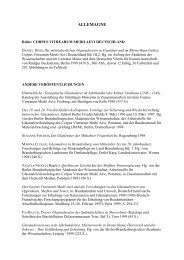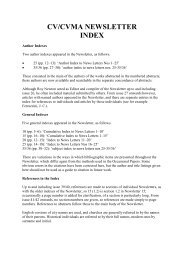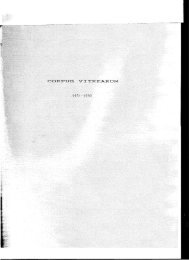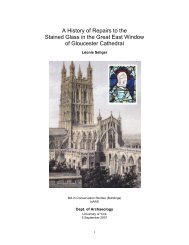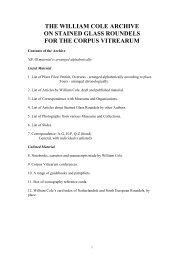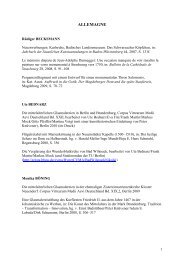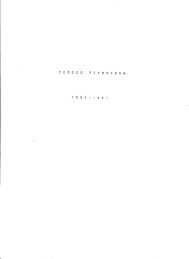BristolConference - Corpus Vitrearum Medii Aevi
BristolConference - Corpus Vitrearum Medii Aevi
BristolConference - Corpus Vitrearum Medii Aevi
You also want an ePaper? Increase the reach of your titles
YUMPU automatically turns print PDFs into web optimized ePapers that Google loves.
Oxford, Merton College<br />
This is one of the earlier colleges in the<br />
university. A statute was established in 1264by<br />
Bishop WaIter Merton, Chancellor to King<br />
Henry Ill. The hall may date from his time, with<br />
its splendid transomed windows (heavily<br />
restored) and original ironwork on the door.<br />
The chapel was begun later, in 1289,replacing<br />
an earlier church, and roofed in 1296-97. Only<br />
the eastern arm and part of the transept of a<br />
great cruciform church were completed. The<br />
resulting T-shape would become standard for<br />
Oxford college chapels. The windows of the<br />
eastern arm demonstrate an interest in tracery<br />
design that is characteristic of the English<br />
reception of Rayonnant architecture in the late<br />
thirteenth century.<br />
The Chapel<br />
The glazing of the eastern arm was underway<br />
in 1294.The glass has been restored at various<br />
dates, notably by Caldwell of Canterbury in the<br />
1930s,but the original forms were maintained,<br />
as earlier drawings demonstrate. Only the main<br />
lights of the east window are completely<br />
unknown; the coloured tracery is largely<br />
original. The main lights of the fourteen side<br />
windows adopt the band window format,<br />
found at about the same date in the Chapter<br />
House and vestibule of York Minster, another<br />
building showing awareness of Rayonnant<br />
precedents. The grisaille grounds have<br />
naturalistic foliage throughout, as on the<br />
Chapter House stairs at Wells,c.1290, and are set<br />
with coloured and painted bosses. The coloured<br />
borders include pseudo-heraldic motifs.<br />
Twelve of the three-light windows centre<br />
Apostles, flanked by kneeling figures of the<br />
donor Henry Mamesfield (d.1328),who appears<br />
no less than twenty-four times, in different<br />
attire. Inscriptions identify him repeatedly as<br />
donor. He was a fellow of Merton in 1288-96<br />
and gave money for the chapel, later becoming<br />
Chancellor of the university and Dean of<br />
Lincoln Cathedral. This is an extreme example<br />
of the multiple commemoration that is a feature<br />
of the period, as for example in the string of<br />
crosses erected by Edward I for Queen Eleanor<br />
(d.1290),or the glass for Raoul de Senlis in an<br />
ambulatory chapel at Beauvais Cathedral, in the<br />
same decade. In the collegechapel, the pattern is<br />
broken only in the pair of windows over the<br />
sedilia (now heavily restored), which contain<br />
representations of saints.<br />
The tabernacles follow the latest architectural<br />
fashion, in the reception of French Rayonnant<br />
forms, and are among the earliest in England<br />
accurately to depict such forms in the twodimensional<br />
medium of glass painting. The<br />
ogee arches in the central niches had been taken<br />
up only in the early 1290s, on the Eleanor<br />
Crosses and at St Stephen' s Chapel in<br />
Westminster Palace. Microarchitectural forms<br />
in other media, metalwork for example, should<br />
not be discounted as an inspiration. There are<br />
several figure styles, but these, too,<br />
demonstrate the latest fashion, including<br />
draperies in the soft style, to be found in<br />
monumental sculpture and in northern French<br />
painting in this decade.<br />
The Merton glass appears to be at the forefront<br />
of formal and stylistic developments during the<br />
1290s, relating generally to the other great<br />
monument of stained glass in southern<br />
England at this period, Exeter Cathedral, and<br />
more closely to surviving fragments from the<br />
Chapter House at Wells. However, it also<br />
relates closely to glazing locally,in Oxford and<br />
Oxfordshire, over the following thirty years.<br />
There are similarities, for example, between the<br />
east window and that in the St Lucy Chapel,<br />
Oxford Cathedral (Christ Church), which<br />
probably dates from the 1320s.<br />
In the main lights of the east window are<br />
figures and heraldry from elsewhere in the<br />
college and chapel. The magnificent Virgin<br />
and Child, and associated figures in the<br />
International Gothic style, are from the<br />
transepts, the northern of which was dedicated<br />
in 1425. They have been attributed to the<br />
workshop of Thomas of Oxford, who had<br />
earlier glazed New College Chapel for Bishop<br />
William Wykeham, c.1380-86. There is other<br />
glass in the region in a similar style, confirming<br />
that Oxford was a major centre for the<br />
production of glass in this period, as it had been<br />
in the earlier fourteenth century.<br />
The present arrangement of the east window<br />
dates from the 1930s, and restoration by the<br />
Caldwells. Previously it had contained enamelpainted<br />
glass by William Price, Senior,<br />
depicting six scenes from the Life of Christ,<br />
1702 - one of the most important painted<br />
windows in England of the first half of the<br />
eighteenth century. This has recently been reset<br />
in the north transept by Barley Studio.<br />
34



